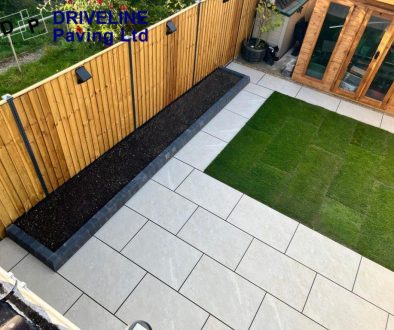Driveway Planning Rules 2025: Permits, Drainage, and SUDS Compliance
Changes to planning regulations and growing concerns about surface water management mean that driveway installations in 2025 demand close attention to permits, drainage and sustainable drainage systems (SUDS). With heavier downpours becoming more common under UK climate patterns, impermeable surfaces risk overwhelming local sewers and causing costly flood damage. For Essex homeowners, early understanding of these rules avoids enforcement notices and safeguards property value.
Homebuyers increasingly value kerb appeal and environmental credentials, so a compliant driveway not only meets legal obligations but also enhances market attractiveness. This guide breaks down the key stages—from Permitted Development Rights through detailed drainage standards and SUDS principles to local authority guidance—ensuring any new driveway combines functionality, style and regulatory compliance.
Understanding the 2025 Driveway Planning Landscape
Recent updates to national policy underscore the need for efficient on-site water management. The Planning Policy Guidance now references SUDS explicitly, while the Flood and Water Management Act 2010 sets out responsibilities for surface water control. The Environment Agency’s advice and the National Planning Policy Framework work in tandem to reduce flood risk by encouraging infiltration over run-off.
Early engagement with these regulations streamlines the planning process. Homeowners who factor in subsoil characteristics, infiltration testing and design requirements from the outset benefit from clearer cost projections and faster approvals. Liaison with planning officers at district councils in Essex—such as Chelmsford or Colchester—can clarify any transitional arrangements or local policy nuances before work begins.
Permitted Development Rights & Planning Permission
Permitted Development (PD) rights allow certain driveway alterations without a full planning application, provided strict conditions are met:
- Area limit: Impermeable surfacing must not exceed 5 m² of the front garden.
- Drainage: Surface water must drain to a permeable area on the property or to a soakaway.
- Protected features: No interference with listed structures, conservation areas or protected trees.
When PD rights are curtailed by an Article 4 direction—or if surfacing surpasses 5 m²—full planning permission is required. Driveway proposals in conservation zones or on listed-property land often demand a Lawful Development Certificate to confirm compliance. Applications typically take eight weeks for determination and incur local authority fees; supplying accurate site plans, drainage statements and elevation drawings is essential for timely approval.
Essential Drainage Requirements for Driveways
Driveway drainage must handle local rainfall intensities while preventing excess run-off. BRE Digest 365 outlines soakaway design based on infiltration tests, which measure the rate at which subsoil absorbs water. Correct test results inform the size of soakaways or sub-surface storage crates needed to accommodate peak flows.
Key drainage measures include:
- Infiltration trenches or soakaways sized to local rainfall data and subsoil permeability.
- BS 6297-compliant geotextile membranes to prevent clogging of the sub-base aggregate.
- Permeable surfacing materials—such as resin-bound gravel or block paving—that allow water to pass through.
- Proper falls (1–2% gradient) directing water away from property foundations.
Maintaining these systems requires occasional jet-washing of the surface and clearing of silt from inspection chambers to preserve long-term performance.

SUDS Compliance: Principles and Best Practices
Sustainable Drainage Systems (SUDS) aim to mimic natural hydrology by controlling water quantity, enhancing water quality and providing amenity benefits. Driveway SUDS solutions manage runoff at source, slow peak flows, filter pollutants and support local biodiversity through filtered infiltration.
Practical SUDS components for driveways include:
- Permeable block paving with interlocking joints and open voids.
- Resin-bound systems incorporate graded aggregates for seamless porosity.
- Filter drains lined with gravel and geotextile fabrics to trap sediment.
- Infiltration trenches or mini-swales along drive edges.
- Sub-surface storage crates that temporarily hold excess water before discharge.
Adopting these features not only meets Environment Agency guidelines but also reduces flood risk and enhances the green credentials of your home.
Essex-Specific Regulations & Local Authority Guidance
Essex County Council and its district authorities publish supplementary planning documents detailing SUDS requirements for surface water management. Certain areas—especially those prone to flooding or within conservation zones—may have Article 4 directions that remove PD rights for impermeable surfacing.
To verify local rules:
- Consult the Essex Planning Portal or download the relevant Local Validation Requirements document for your district (e.g., Basildon, Brentwood, Maldon).
- Review the Strategic Flood Risk Assessment and SUDS Policy sections within your council’s Local Plan.
- Contact planning officers to confirm whether any transitional or special site-specific constraints apply.
Armed with this information, homeowners can tailor designs to local expectations and avoid delays.
Avoiding Common Pitfalls in Driveway Planning
Projects often falter due to incomplete drainage assessments or non-compliant materials. Missed soakaway tests, inadequate sub-base depths and reliance on impermeable tarmac without proper runoff controls are frequent causes of planning refusals and post-installation defects.
Homeowners should observe these practical tips:
- Commission a professional infiltration test to establish accurate subsoil permeability.
- Choose SUDS-approved materials and verify their permeability ratings.
- Confirm boundary limits and any utility easements before laying surfacing.
- Check for Article 4 directions or conservation area constraints.
- Ensure detailed drainage statements accompany planning submissions.
- Engage with the highways authority if a vehicle crossover impacts the public footway.
Following these steps helps avoid costly alterations and ensures a robust, compliant driveway.
Ensuring Compliance: Partnering with Professional Installers
Trusted providers deliver the expertise needed to navigate planning rules and technical demands. Professional services begin with a thorough site survey, covering soil testing, topographical analysis and review of local policy documents. Based on these findings, detailed CAD drawings and SUDS calculations are prepared for planning applications.
During installation, expert teams handle excavation to designed depths, precise layering of sub-base materials, placement of geotextile fabrics and fitting of specified surfacing. They also provide clear documentation for Building Control and may offer post-completion inspections to verify drainage performance. With workmanship guarantees and ongoing maintenance plans, homeowners gain confidence in both compliance and longevity.
Compliance, Durability and Style—All in One
Meeting the 2025 planning rules for driveways in Essex involves understanding your Permitted Development Rights, adhering to precise drainage requirements and incorporating SUDS best practices. By consulting local authority guidance early, avoiding common pitfalls and partnering with professional services, homeowners can achieve a driveway that is both compliant and visually appealing.
To secure a durable, regulation-compliant driveway with expert installation and free, no-obligation advice, visit our contact page and request your quote today.





